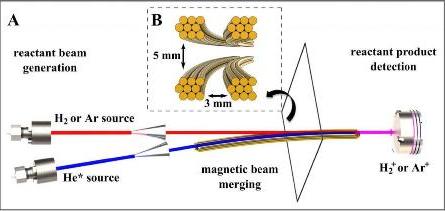Oct 12 2012
At very low temperatures, close to absolute zero, chemical reactions may proceed at a much higher rate than classical chemistry says they should – because in this extreme chill, quantum effects enter the picture.
 The experimental system is comprised of two supersonic valves followed by two skimmers. The blue beam passes through a curved magnetic quadrupole guide, and the merged beam (purple) enters a quadrupole mass spectrometer. B is a front view of the quadrupole guide. (credit: Weizmann Institute of Science)
The experimental system is comprised of two supersonic valves followed by two skimmers. The blue beam passes through a curved magnetic quadrupole guide, and the merged beam (purple) enters a quadrupole mass spectrometer. B is a front view of the quadrupole guide. (credit: Weizmann Institute of Science)
A Weizmann Institute team has now confirmed this experimentally; their results would not only provide insight into processes in the intriguing quantum world in which particles act as waves, it might explain how chemical reactions occur in the vast frigid regions of interstellar space.
Long-standing predictions are that quantum effects should allow the formation of a transient bond – one that will force colliding atoms and molecules to orbit each other, instead of separating after the collision. Such a state would be very important, as orbiting atoms and molecules could have multiple chances to interact chemically. In this theory, a reaction that would seem to have a very low probability of occurring would proceed very rapidly at certain energies.
Dr. Ed Narevicius and his team in the Institute's Chemical Physics Department managed, for the first time, to experimentally confirm this elusive process in a reaction they performed at chilling temperatures of just a fraction of a degree above the absolute zero – 0.01°K. Their results appeared this week in Science.
"The problem," says Narevicius, "is that in classical chemistry, we think of reactions in terms of colliding billiard balls held together by springs on the molecular level. In the classical picture, reaction barriers block those billiard balls from approaching one another, whereas in the quantum physics world, reaction barriers can be penetrated by particles, as these acquire wave-like qualities at ultra-low temperatures."
The quest to observe quantum effects in chemical reactions started over half a century ago with pioneering experiments by Dudley Herschbach and Yuan T. Lee, who later received a Nobel Prize for their work. They succeeded in observing chemical reactions at unprecedented resolution by colliding two low-temperature, supersonic beams. However, the collisions took place at relative speeds that were much too high to resolve many quantum effects: When two fast beams collide, the relative velocity sets the collision temperature at above 100°K, much too warm for quantum effects to play a significant role. Over the years, researchers had used various ingenious techniques, including changing the angle of the beams and slowing them down to a near-halt. These managed to bring the temperatures down to around 5°K – close, but still a miss for those seeking to observe chemical reactions in quantum conditions.
The innovation that Narevicius and his team, including Alon B. Henson, Sasha Gersten, Yuval Shagam and Julia Narevicius, introduced was to merge the beams rather than collide them. One beam was produced in a straight line, and the second beam was bent using a magnetic device until it was parallel with the first. Even though the beams were racing at high-speed, the relative speed of the particles in relation to the others was zero. Thus a much lower collision temperature of only 0.01 K could be achieved. One beam contained helium atoms in an excited state, the other either argon atoms or hydrogen molecules. In the ensuing chemical reaction, the argon or hydrogen molecules became ionized – releasing electrons.
To see if quantum phenomena were in play, the researchers looked at reaction rates – a measure of how fast a reaction proceeds – at different collision energies. At high collision energies, classical effects dominated and the reaction rates slowed down gradually as the temperature dropped. But below about 3°K, the reaction rate in the merged beams suddenly took on peaks and valleys. This is a sign that a quantum phenomenon known as scattering resonances due to tunneling was occurring in the reactions. At low energies, particles started behaving as waves: Those waves that were able to tunnel through the potential barrier interfered constructively with the reflected waves upon collision. This creates a standing wave that corresponds to particles trapped in orbits around one another. Such interference occurs at particular energies and is marked by a dramatic increase in reaction rates.
Narevicius: "Our experiment is the first proof that the reaction rate can change dramatically in the cold reaction regime. Beyond the surprising results, we have shown that such measurements can serve as an ultrasensitive probe for reaction dynamics. Our observations already prove that our understanding of even the simplest ionization reaction is far from complete; it requires a thorough rethinking and the construction of better theoretical models. We expect that our method will be used to solve many puzzles in reactions that are especially relevant to interstellar chemistry, which generally occurs at ultra-low temperatures."